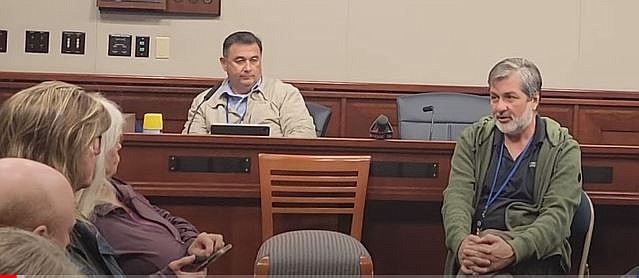Loveland Reservoir trail money eyed for bridge, parking lot, fish stocking, more water
And there's the treacherous bluff
Sweetwater Authority officials and Loveland lake users are discussing what to do with a $750,000 state grant the agency has received for trail improvements.
In the first workshop this month, which a late change of venue from Alpine to Chula Vista didn't prevent a large crowd from attending, ideas flew about not only maintaining trails — but water levels.
While the funding is earmarked for trails and their access, for many Loveland visitors (in East County, just south of Alpine), trails are for getting to fishing spots.

One idea favored by the Authority is to rebuild the bridge
“Basically, the area was eroded and there’s no way to get from one side of the trail to the other," said Carlos Quintero, general manager of Sweetwater Authority.
The trail is Sweetwater’s property, but an easement granted to the forest service, who administers it, provides public access for hiking and fishing at the reservoir, which also provides drinking water to Sweetwater customers in National City, Bonita, and parts of Chula Vista.
That access has been limited, lake advocates say, by draining of the lake to benefit water customers and curtailed hours compared to the "sunrise to sunset" the easement describes.
Loveland visitors' efforts to make it more accessible were helped by Senator Brian Jones, who spearheaded the grant, and whose representatives Andrew Hays and Kyle Hermann attended the workshop, along with Alan Pellacani from the office of Congressman Darrell Issa.
Most of the trails around the lake were created by recreational users, said David Thomas, who has been fishing at Loveland for 40 years and hiked "every trail out there."
But no trails are being maintained.
"Some of the most dangerous hiking I've done in my life is around this lake because of the fact we don't have any maintained trails."
Lacking a good trail system around the lake, people show up "that have no idea what they're walking into," he added. Young kids see the fish on the other side and try to get around to where they are.
"That $750,000 could go a long way hiring crews" to cut trails all around the lake that give access to "the whole fishing area, not just the little area that's down there when you walk to the bottom of the trail."
On one side, he said, is a treacherous bluff where people often fall and get hurt. "You should cut a fairly good trail through that."
A bridge would help them get from one side to the other to fish, he said. But where it should go was in question. Other advocates said there was no point in putting it where it was already easy to fish. Their surveys had found the main thing anglers want are easy routes around the lake.
Quintero said a bridge across the river could be submitted as an idea but they are "working on jurisdictional waters of the U.S." and there would have to be buy-in from Army Corp of Engineers and Regional Water Quality.
Community proposals include such amenities as a second parking lot on Japatul Road; a direct trail from the parking lot to the east end of the current fishing program; possibly using SDG&E maintenance roads; and extending the shoreline west on both the north and south side of the lake.
And water.
Part of the trails are within the fishing program, one speaker noted.
Mary Hicks, chair of Friends of Loveland Reservoir, asked officials if the fish would be restocked. "You guys wiped out the fish. And you should bring them back. Separate from the grant for trails."
Lake advocates, still worrying the lake will be drained again in the future, asked for a commitment to maintain the minimum water level for fishing.
Quintero said fish restocking could be part of the proposals but he wasn't going to talk about "operational issues. I think they go beyond the ways to use this grant."
Lake advocate Russell Walsh said they were just trying to fix problems with erosion that were caused by the draining. That would return the "normal fishing program," he said.
Quintero asked if he was saying they should keep the water above the bluffs?
"We don't want to build trails or work with the $750,000 on things that are going to be below the water most of the time," Walsh replied.
Quintero said that "delineating a trail above where the water is now makes sense."
There will be more workshops to weigh the proposals, including in Alpine, before the plan is sent to the California Department of Water Resources.
On December 28, Friends of Loveland Reservoir plans to hold its first public board meeting at 9:30 a.m. at the Loveland Reservoir parking lot.